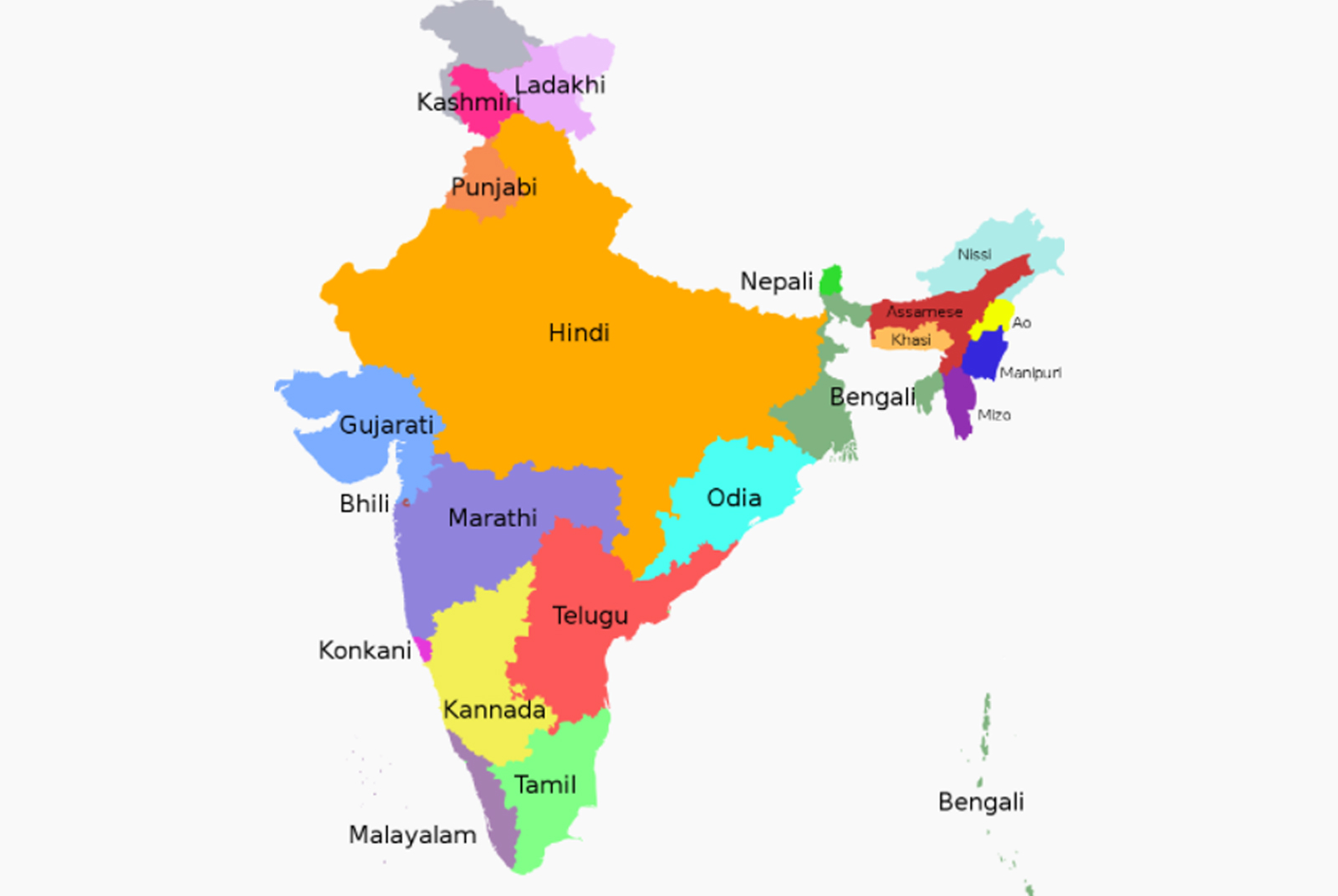Lessons for bilingual Taiwan - the case of India

Source:Shutterstock
The government announced that Taiwan will become a bilingual country in 2023. This not only means that Taiwan will move towards internationalization, but also means that the indigenous languages will face a crisis of disappearance. How can the government balance the aims of ‘internationalization’ and ‘Taiwanization’?
Views
Lessons for bilingual Taiwan - the case of India
By Naina Singh, Maxwell Wappelweb only
With the arrival of Tsai Ing-wen (蔡英文) on Taiwan’s political landscape, the nation has made major strides towards both internationalization and Taiwanization of the country. With the set objectives of de-sinicization of the Taiwanese economy, society and culture, the current administration has actively supported the restoration and revival of the ‘self’ Taiwan lost under colonial and then nationalist government subjugation.
Language(s), an inalienable part of one’s national and global identity; are among the first targets of consideration in this revitalization of the Taiwanese nation. In 2019, National Languages Development Act designated the languages of sixteen officially recognized indigenous tribes of Taiwan as national languages, in a parry against the decades old practice of imposed Mandarin monolingualism. But, before local multilingualism could become an accepted norm within Taiwanese society, the Executive Yuan introduced the Bilingual Nation 2030 Plan, which set up a parallel aim of raising English proficiency among Taiwanese to improve the nation's soft power and ‘gradually’ making English an official language. This introduces a flurry of new hurdles to overcome in the continuing process of Taiwanization.
One of the strategies to achieve this aim is to implement the full scale bilingualization of Taiwan’s educational system, with a dynamic teaching approach to focus on daily English use. An ambitious aim such as this begs the question; ‘how would this bilingualism interact with the noble aim of a multilingual Taiwan?’, in other words, ‘can Taiwan balance these parallel aims of ‘internationalization’ and ‘Taiwanization’ at the same time?’
To navigate this sensitive and consequential topic, this article attempts to critically reflect on previously attempted strategies for success in bilingual education, particularly through studies conducted by US scholars and also experience of India, to caution Taiwan of the challenges and damage that can be done in attempting top-down bilingual education plans.
Bilingualism, in this reflection, refers simply “to the ability to use two languages in everyday life.” (Wei, 2000). The dynamism encapsulated in this broad definition is critical to the policy and implementation of bilingual education in Taiwan. This understanding allows the concept to express itself based on its context: a college student, a professional, or a primary school student may all fit the moniker of bilingual, for different reasons and to fulfill different ends.
Thus, a comprehensive view of what bilingualism means in the Taiwanese context requires us to move forward from a static Mandarin-English definition of the term. For the purposes of this paper, we will assume that the current administration’s goals are taking the long view of bilingualism, such that increasing Taiwan’s soft power and economic competitiveness through English will require a whole-of-society approach that necessitates intrusion into early education as well as professional development.
The admittedly powerful English-Mandarin duo; being a well established, institutionalized and demand-driven phenomenon, has the potential to push vulnerable native languages of the island towards extinction or irrelevance. In their 2019 study on indigenous language in Taiwan, authors Chen-Feng Joy Lin, I-An Grace Gao, and Pi-I Debby Lin noted that the younger indigenous population, already, hardly uses their mother tongues (MT) for daily conversations.
 (Source: CommonWealth Magazine)
(Source: CommonWealth Magazine)
The existing challenges of incoherent policy coordination, inadequate number of well-trained indigenous language teachers and the treatment of minority languages as, in practice, another foreign language class for 40 minutes per week raises doubts that the implementation of Bilingual Nation Plan in its current form ‘will not constrain native language education’. In multilingual societies; as cogently stated by Ajit Mohanty; languages are intrinsically associated with power and hierarchy with some enabling access to greater privileges while other leading to discrimination.
The English trap
India is the only country to have a staggering 22 official languages, but it is the home to a truly breathtaking 19,500 mother tongues and dialects, according to a 2011 census of the country. The blueprint of the Bilingual Nation Plan lauds India as one of the exemplary examples of high levels of English literacy, but such an outlook reflects only the tip of the linguistic iceberg.
Over the years, this colonial language has not only reproduced the existing societal inequalitie+s in India but has also created new ones. For many Indians today, English is not just a skill to achieve social mobility, it is a ‘life-style’ statement and that influences their whole knowledge system and worldview.
Despite the Indian government attempts to preserve and cherish special features of multilingualism in India as early as the 1950s-60s via formal education, the sociolinguistic giant has struggled to narrow the gap between dominant languages such as English or regional languages as well as indigenous and minority languages.
 (Source: Wikipedia CC BY-SA 4.0)
(Source: Wikipedia CC BY-SA 4.0)
Like in many other national contexts, minority languages are constantly considered inadequate and underdeveloped for educational and scientific use in India, leading to their further marginalisation vis-a-vis languages such as English or Hindi. In the context of globalisation, the media, internet and popular culture show an ever increasing infatuation with the use of English, exacerbating its existing and distinct hierarchical divide with regional and tribal languages. Ajit Mohanty describes it as two major ‘power cleavages’: one, the “English-Vernacular Divide,” and second, the “Vernacular-Other Divide.”
In championing English as a foreign language, English has increasingly become a second language for the majority of Indians and ‘a communication link’ among diverse language communities. The economic and social benefit attached to English has made the language a selling point for private schools in urban and semi-urban regions of India. Such schools exclusively use English as their language of instruction from the earliest stages of kindergarten. English is not a common home language of many Indians, but with the growing middle class and upper middle class in the country the demand for English medium private schools has increased due to their higher quality of education in spite of the high cost.
In the opinion of many teachers in India, English has created a new caste system and exacerbated the already existing social divide in Indian society. The knowledge of English is used to patronize those who can’t master it or even those who speak with heavy local accents.
In the Taiwanese context, there is evidence that a similar social process happens with Mandarin. Stereotypes of Taiwanese and Mandarin speakers have been proven empirically. Listeners tend to view speakers of Mandarin as having higher education and social status (Lu, Chang, 2014). Avoiding calcification of social stratification through the state mandate of language education, a realm in which Taiwan has so much history and experience, would not be an easy endeavor and is likely the inevitable outcome of top-down language policy if it is not highly attuned to local needs.
Assimilation: A familiar by-product
A continuing issue in the domain of bilingual education is that of assimilation. An assimilative bilingual program uses the student’s native tongue only to the extent that it facilitates learning the second language (usually the default teaching language of the school). Majority of western nations such as United States use these transitional bilingual education where the role of a minority language that the learner is familiar, for example Spanish, is to assist in gradual transition towards majority language i.e. English, as described by Baker in 2006.
This leads to a teaching methodology whose end goal is to extricate the native language from classroom use, or, alternatively, second language schemes that separate the student from the core curriculum in order to raise their language proficiency until they can be taught in the local language-- a common format in US public schools. As Baker describes in his voluminous work on the subject, transitional education programs “aim to give students English language skills sufficient for them to be able to converse with peers and teachers in mainstream education and to operate in the curriculum. Having achieved surface fluency, they may be transferred to mainstream education.”
Nations such as India, where multilingualism is an established societal norm and a part of national identity have attempted to approach the issue differently, if not entirely successfully. To strengthen multilingualism and promote national integration via a formal education system, the Three Language Formula (TLF) was adopted as an national education strategy via 1968 National Policy on Education (NPE). Considering the regionally bounded language communities in India, the TLF depended on decentralization as it advised state governments.
 (Source: Shutterstock)
(Source: Shutterstock)
In the Hindi-speaking belt, the government advised states to include English and a modern Indian language, preferably a southern Indian language, while non-Hindi speaking states were advised to study their regional language, Hindi and English. A special emphasis was also given to develop Hindi as a connecting language and strengthen English in an effort to accumulate and add to general global knowledge. Such full bilingualism practices; inclusive of multilingualism; aim to develop and maintain skills in two languages, to include literacy, as described by Fishman & Lovas in 1970.
The TLF has achieved partial success in providing equal space for languages across the nation, but its implementation has been a challenge and uneven between states. All the recommended languages are rarely taught compulsorily at secondary levels and most of the Hindi-Belt states focus more on teaching of classical languages such as Sanskrit as their third language rather than the modern Southern Indian languages, as advised. Over the years the formula has become a point of contention between the central government and southern states because of its active imposition of Hindi language on non-Hindi speaking regions, leading to implementation of a two-language formula in some regions; Tamil Nadu i.e. Tamil and English for example. Furthermore, it cannot be overlooked that the maintenance of dominant regional languages as the Medium of instruction (MoI) in school has directly added to language homogenization and assimilation, especially in tribal areas.
Linguistic rights of minority languages are usually protected by the Indian constitution, but this does not necessarily come into effect at the level of formal education. As pointed out by Dhir Jhingran, non-scheduled languages, those not mentioned in the Eighth Schedule of the Indian constitution, are rarely used as a medium of instruction outside North-Eastern India. Students who belong to indigenous tribes or whose languages are considered a dialect of a dominant regional language inevitably start their education with an unfamiliar second language.
Educators’ consequential role
The role of teachers, the day to day implementers of bilingualism, is hugely related to the effectiveness of schemes such as the TLF or Bilingual Taiwan 2030.
The language proficiency and background of teachers play a consequential role in preventing or further facilitating the tendency of bilingual programs to be assimilative. According to Winke and Gass, studies have found that the deployment of teachers of second languages to localities where they do not share the primary heritage language tends to be reflected in teacher bias. Ensuring teachers familiarity with a student's primary language makes a substantial difference in the acquisition of a second language, and theoretically reduces the likelihood of a fully assimilative program that creates other negative social externalities.
There is a surplus of anecdotal evidence from the United States that having teachers who are viewed as a member of the local community by the students creates a more productive learning environment. According to Bartelt, local teachers are more familiar with the diverse linguistic and cultural environment of the area, and serve as “bicultural role models” for their classes -- while teachers who come from outside the community often have limited knowledge of their class and tend to enforce a purist variety of the target language.
According to Freeman and Johnson’s 1998 work, the value of teachers who share the customs and culture of their students, or at the very least are “learners of teaching” that take into account “social context of schools and schooling within which teacher-learning and teaching can occur” is irreplaceable. While it may not always be necessary or possible to hire and train teachers directly from local communities, in general there has been a lack of focus on teacher knowledge-base when it comes to the study of bilingual education as a separate and distinct field from the content that the teacher is instructing. If nations are to effectively execute well meaning bilingual education policies, they must take into account the human capital element of the education process -- particularly the training, cultural, and class backgrounds of their teacher workforce, not simply on a national level but in the localities where the most “language friction” will be encountered.
What Taiwan can learn: Creating a winning strategy
An effective bilingualism strategy for the island needs to prioritize the social, economic, and cultural benefits for the learner and protect Taiwan’s language and cultural diversity. Formal education should be a platform to not only avoid exacerbating historical inequities, but work towards resolving their continuing role in creating unjust social or economic outcomes.
 (Source: CommonWealth Magazine)
(Source: CommonWealth Magazine)
First, we recommend the inclusion of indigenous languages as the medium of instruction at the primary school level in an effort to give it an equal footing with Mandarin and English, in all schools where this policy would apply.
India has experimented with such schemes: for example, the Indian states of Andhra Pradesh and Orissa, which have a substantial tribal population, started a pilot project to teach all subjects from grades I-V in tribal mother tongues and only transfer to English or regional language medium of instruction after their primary grades. Taiwan must be willing to approach this problem granularly, perhaps even at the level of school, to determine which mediums of instruction best suit which communities.
The prioritization of human capital development and of hiring teachers who have an intimate understanding of local languages and culture is a possible solution for implementing a successful bilingual education scheme. In the context of Taiwan, it’s important to avoid the tendency to “view teaching as discrete behaviors, distance their conclusions about teaching from the contexts within which it occurs, and ignore the individual perspectives and understandings of the teachers who carry out the very teaching practices that they have studied,” as it may limit the ability of language programs to adapt over time. Training these teachers will take time, but will lead to a truly bilingual Taiwan.
Second, the existing geographical distribution of Taiwanese languages naturally calls for a greater role and decision-making authority for local governments and community-level participation in the language policy of the state.
The Indian case lends helpful insight here if Taiwan wants to balance the development of its diverse language setting with English as an official language. The majority of the Indian population is bilingual in terms of complete literacy in two languages but every state community has its own bilingualism. The majority of the population in Non-Hindi speaking states can understand or may speak in Hindi but they might not consider it as their second language. When combined with community-centered, community led education philosophy, a bilingual language policy can help protect local languages while educating bilingual citizens.
Localities should be free to choose whether their second language of instruction is English or Mandarin, with the primary language of instruction being that language most commonly used by most students. Thus, schools in Taipei might differ significantly from schools in Hualien in terms of their bilingual school offerings. This introduces its own problems, such as how to address smaller minority language groups, however this problem is best resolved in a highly local context rather than at the level of national policy.
In other words, while pursuing bilingualism, Taiwan must be flexible in its implementation to avoid the mistakes that many other bilingual programs have shown are major roadblocks to success. Are Taiwanese policymakers prepared to do the heavy-lifting of politics that will lead to a reformed Bilingual Plan? It remains yet to be seen.
Finally, the current government must encourage or regulate both private and cram schools to provide equal importance to development of local languages and indigenous culture in parallel to English.
Currently, promotion and preservation of native languages is either observed by government or under-funded Non-government agencies. This is not simply a matter of aligning with cultural sensitivities and inclusiveness -- giving local languages more agency in schools has proven to create better academic outcomes. Asystematic and well-coordinated effort with all relevant stakeholders at the planning table is the only way to move ahead -- rather than pursuing a policy which is the brainchild of a small segment of Taiwanese society.
Taiwan’s political, economic, social and education scene have been under the restrictive umbrella of official language policy for decades, systematically subjugating native and indigenous languages, both intentionally and unintentionally. At this temporal and geographic crossroad of globalization, localization and democratization, Taiwan needs a bilingual policy which is inclusive of its multilingual and multicultural heritage. The importance of English for Taiwan is undeniable, but there is also no contextual or historical legacy in Taiwan to justify English as an official language. If English as an official language is seen by policymakers as part of the march through modernity for Taiwan, acceptance of language diversity must also be part of that march. In sum, bilingualism in Taiwan may mean different things for different people.
The intention and objectives of the Bilingual Nation Plan 2030 are noble and laudable but ‘bilingualism’ is a loaded term which must be specifically defined. It merits a coherent explanation and closer inspection than currently attributed in the plan. The Taiwanese approach to bilingualism needs to consider its socio-cultural and demographic context. Given the linguistic heterogeneity of the island, its bilingualism cannot be the same as its reference nations of Singapore and Hong Kong, but should learn from what larger, linguistically diverse nations have both succeeded and failed in implementing.
(This piece reflects the author's opinion, and does not represent the opinion of CommonWealth Magazine.)
About the author:

Naina Singh : Naina Singh is a junior researcher at Taiwan NextGen Foundation and a PhD Candidate at National Chung Hsing University, Taichung. She is also a Ministry of Education Scholarship recipient dedicated to maintaining the momentum between Taiwan-India relations. Her research focus lies in exploring subnational diplomacy of Indian and Chinese states, Taiwan's soft power and Sustainable Development Discourse in Asia.

Maxwell S Wappel :Maxwell Wappel is a Research Associate at Taiwan NextGen Foundation, where he contributes to the New Southbound Policy and Taiwan's Soft Power. He is a Master's candidate at the Johns Hopkins School of Advanced International Studies, majoring in international relations.
Have you read?
♦ Taiwan’s Bilingual Education Needs Critical Thinking
♦ Taiwan doesn't really want to be a "bilingual country"
Uploaded by Penny Chiang






